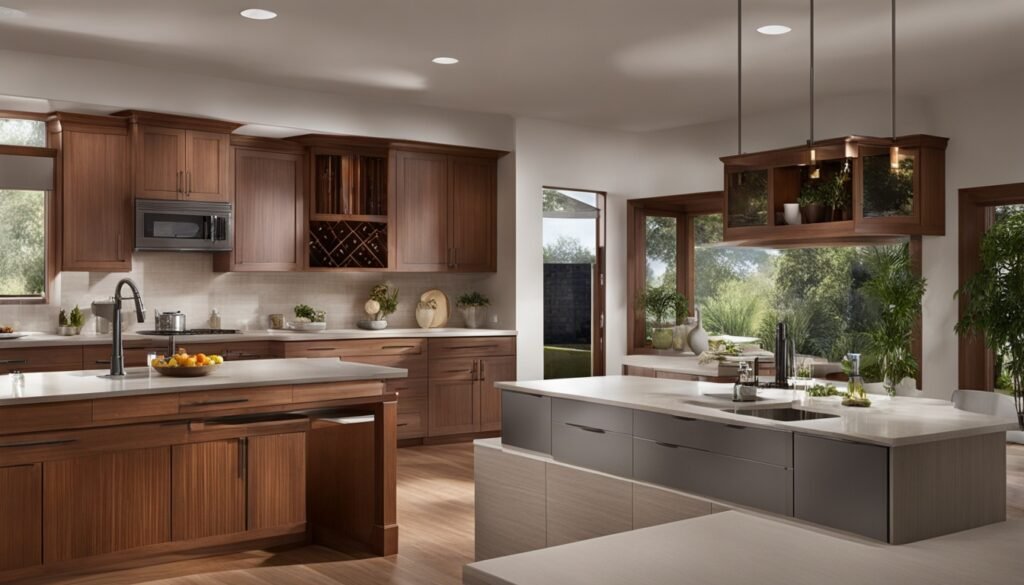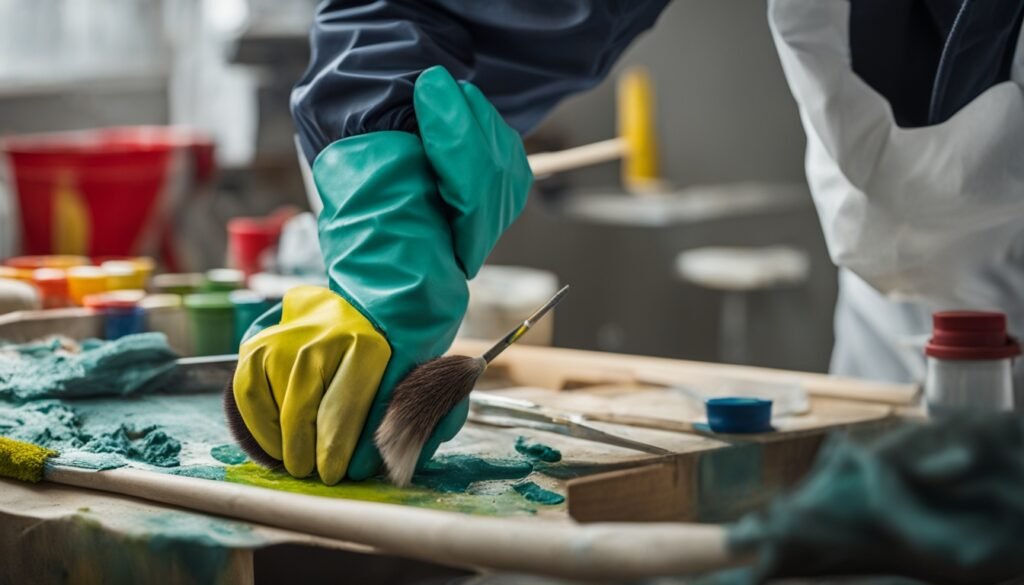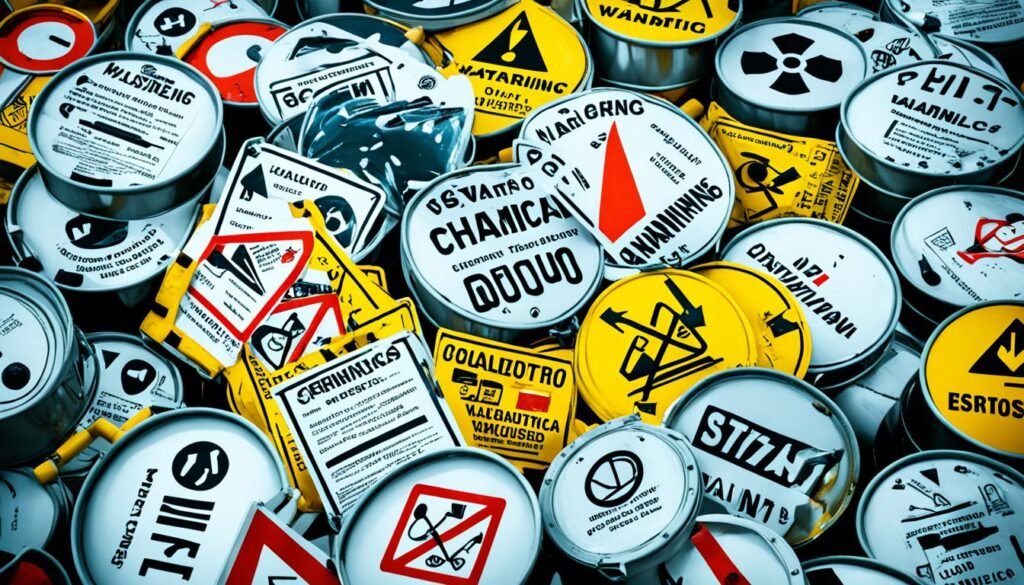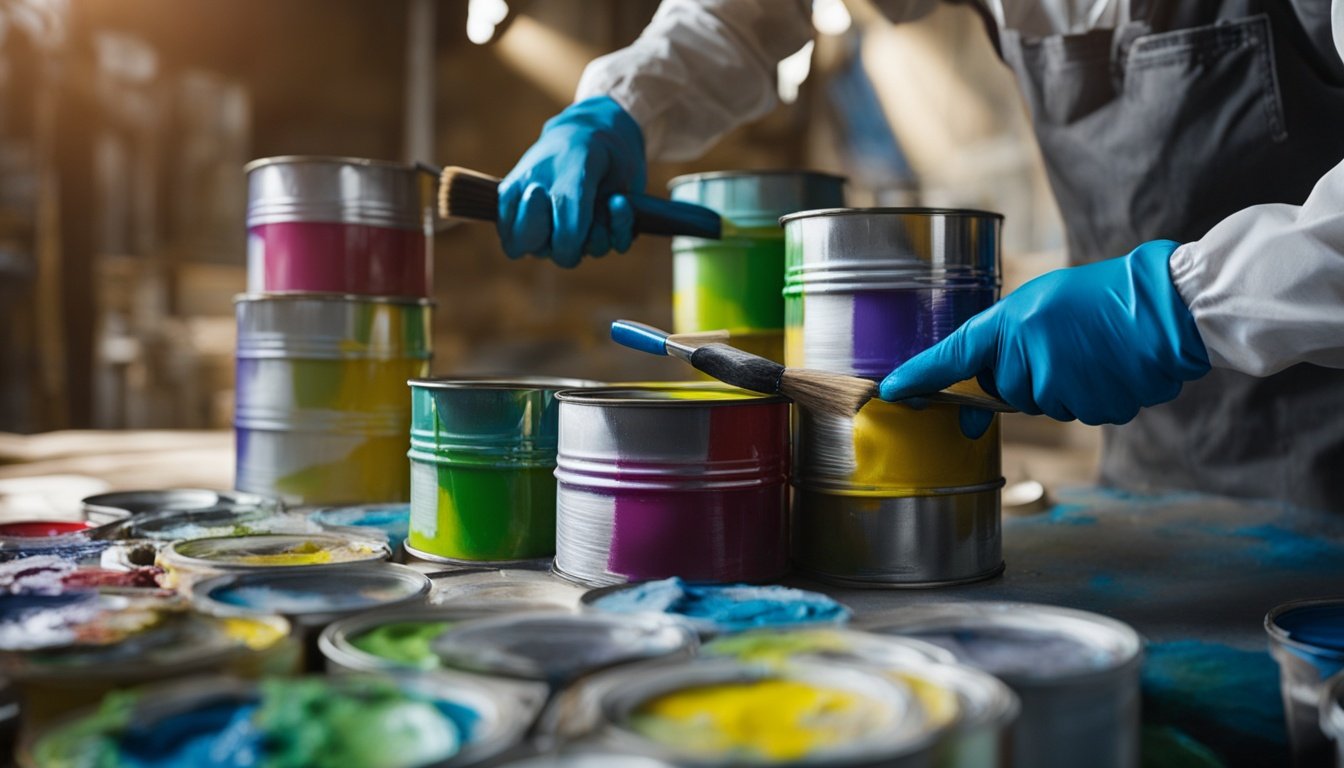Starting a home renovation project can be thrilling, but don’t forget to focus on safety first. Painting your home can be a fun DIY project. Yet, it’s key to keep your health and safety in mind. This guide will share important painting safety tips for a safe and healthy home.
Whether you’re painting one room or the whole house, safety first is crucial. We’ll cover how to pick safe paints, use proper ventilation, and dispose of materials correctly. This will help you paint with confidence and safety.
Key Takeaways
- Prioritize the use of low-VOC or water-based paints to minimize exposure to harmful fumes.
- Ensure proper ventilation by opening windows, using exhaust fans, and providing adequate airflow.
- Wear appropriate respiratory protection, especially when working with solvent-based products.
- Protect your eyes and skin with the proper personal protective equipment (PPE).
- Follow safe handling and disposal guidelines for leftover paint and hazardous materials.
Safe Paint Selection
When you start painting, think first about your home and health safety. It’s key to pick the right paint type. Choose low-VOC (volatile organic compounds) or water-based paints. They give off fewer bad fumes than old oil-based paints.
Before deciding, read the product labels and safety information on the paint cans. This tells you about the health risks and safety steps you need to take while painting.
Choose Low-VOC or Water-Based Paints
Low-VOC and water-based paints are safer for your project. They don’t release as many harmful chemicals. This makes them a better choice for you and your family. 70% of professional painters now pick low-VOC or no-VOC paints because they care about health and safety.
Read Product Labels for Safety Information
- Check the product labels for health risks and safety tips.
- See the volatile organic compound (VOC) info to know about fumes during use.
- Notice any warnings or cautions about skin or eye irritation, and ventilation or breathing masks needed.
By choosing low-VOC or water-based paints and checking safety info, you make painting safer for your home. Taking time to pick wisely protects your health during the project.
Proper Ventilation
When painting indoors, it’s key to have good ventilation. Open all windows and doors to let in fresh air. This cuts down on harmful Ventilation and keeps the air healthy during and after painting.
Use Exhaust Fans to Remove Fumes
Opening windows and doors isn’t enough. Using Exhaust Fans helps clear out paint Fume Removal. Standalone or ceiling fans can also boost air flow and Ventilation. If it’s cold, a portable heater can keep the room comfy while you work.
| Ventilation Tip | Benefits |
|---|---|
| Open Windows and Doors | Allows for cross-ventilation and exchange of fresh air |
| Use Exhaust Fans | Actively removes paint fumes from the work area |
| Utilize Standalone or Ceiling Fans | Improves air circulation during painting |
| Use a Portable Heater (for colder months) | Maintains room temperature while providing ventilation |
In areas with poor air flow, choose water-based paints with low VOCs. These paints have fewer harmful fumes. Taking breaks often while painting indoors also helps avoid too much exposure to paint fumes.

“Proper ventilation is crucial when painting indoors to minimize the effects of fumes, especially for children.”
Respiratory Protection
When you work with solvent-based paint, wearing a respirator is key to avoid breathing in harmful fumes. It’s vital for keeping you safe during painting jobs that involve volatile organic compounds (VOCs) and other dangerous airborne particles.
Wear Respirators for Solvent-Based Products
Choose a respirator that filters out organic vapors and particles. This adds an extra safety layer, letting you finish your painting safely. Brands like 3M are often suggested for painting tasks.
Inhaling chemicals from paints and thinners can cause serious health issues. These include asthma, nervous system problems, and even cancer. Common thinners contain Isopropyl alcohol, Butanone, and other substances that can irritate your skin, eyes, and lungs.
It’s best to use respirators with filters that can handle VOCs with boiling points above 60°C (140°F). Keep these filters away from chemicals, clean your masks regularly, and replace them when needed. This is part of staying safe.
“Respirator masks are essential for painting and renovation projects. They protect you from chemicals, harmful vapors, and mold spores, keeping tiny and odorless particles out of your airways.”
The main aim of painting safety is to stop VOCs from getting into your airways and bloodstream. Keep pets away, consider a painting booth for better air flow, and have a plan for spills.
MSDS (Material Safety Data Sheets) tell you what’s in products, helping you stay safe and healthy while painting. Putting respiratory protection first ensures a healthy home when you’re painting.
Eye and Skin Safety
When painting, keeping your eyes and skin safe is key. It’s important to use the right personal protective equipment (PPE) to avoid irritation, rashes, or other bad reactions.
Wear Protective Gloves and Clothing
Wearing protective gloves is a must to stop your skin from touching paint and solvents. Choose gloves made of strong materials like nitrile or latex that can handle harsh chemicals well. Also, wear long-sleeved clothes to reduce the chance of getting paint on your skin.
- Choose protective gloves that fit well and give you good coverage and flexibility.
- Opt for long-sleeved shirts and pants to protect your skin from paint splatters and fumes.
- Consider eye protection like safety goggles or face shields to keep your eyes safe from chemicals and accidents.
By taking these steps, you can have a safe and healthy painting experience. This way, you keep your eye safety and skin safety in check.

“Proper personal protective equipment is essential for a successful and safe painting project. Don’t take chances with your health and well-being.”
Painting Safety Tips to Keep You Safe and Healthy for your home
Follow these Painting Safety Tips for a safe and healthy painting project at home. Choose low-VOC or water-based paints and keep the area well-ventilated. Always wear protective gear to stay safe. This way, you can make your living space look new without risking your health or your family’s.
Here are some tips to keep your home safe and healthy while painting:
- Choose low-VOC or water-based paints to reduce exposure to harmful fumes.
- Ensure proper ventilation by opening windows and doors, and using exhaust fans to remove paint vapors.
- Wear a respirator when working with solvent-based paints to avoid inhaling excessive fumes.
- Protect your eyes and skin by wearing protective goggles, gloves, and clothing.
- Follow safe disposal guidelines for leftover paint and properly store any remaining supplies.
- Take precautions when dealing with lead-based paint, which can be hazardous to your health.
- Maintain ladder and scaffold safety to prevent falls and injuries.
By following these Painting Safety Tips, you can make your home safe and healthy. You’ll be able to complete your DIY painting projects with confidence. Remember, being careful is key to enjoying a fresh look without health risks.
Handling Hazardous Materials
Handling hazardous materials safely is key when you’re painting. Many household items like oven cleaners and rust removers are dangerous if not used right. If not handled correctly, they can cause serious harm, including injury, illness, and even death.
Follow Safe Disposal Guidelines
Always follow the safe disposal rules for hazardous materials like leftover paint and solvents. Don’t pour these down drains or into nature. This can cause big problems. Instead, call your local waste management to find out how to dispose of hazardous waste safely.
Store Leftover Paint Properly
Keep leftover paint in sealed containers, out of reach of kids and pets. This helps avoid spills and keeps you safe from harmful materials. Keep flammable liquids like gasoline in cool, dry places away from heat and sunlight to prevent fires.
Being careful with hazardous materials is important. By following the right disposal steps and storing paint safely, you keep yourself, your loved ones, and the planet safe from harm.
| Hazardous Household Product | Proper Handling and Disposal |
|---|---|
| Oven Cleaners | Read labels for safety information, wear protective gloves, and dispose of properly according to local regulations. |
| Tile Cleaners | Use in a well-ventilated area, avoid skin contact, and dispose of containers at a hazardous waste facility. |
| Rust Removers | Follow manufacturer’s instructions, wear eye protection, and never pour down drains or onto the ground. |
| Gasoline | Store in a cool, dry place away from heat and ignition sources, and take it to a hazardous waste collection site. |

“Improper handling of Hazardous Materials can have devastating consequences. It’s crucial to follow safe disposal guidelines and store leftover paint properly to protect yourself, your family, and the environment.”
Lead-based Paint Precautions
If your home was built before 1978, it’s key to test for lead-based paint before painting. Lead paint can be harmful, especially to kids. The EPA says that any renovation in a pre-1978 home must be done by certified contractors.
Test for Lead-Based Paint
To find out if there are lead hazards, you must test for them. A pro can do a lead inspection with special machines or lab tests. Or, you can buy a lead test kit to check for lead paint yourself.
If the test shows lead is present, it’s best to hire a pro for safe removal and cleanup. This ensures your home stays safe.
Proper Removal and Cleanup
Lead-based paint needs to be removed and cleaned up properly. Safe removal methods include wet scraping, wet sanding, and heat removal. Avoid open flame burning and abrasive sand blasting.
After removing the paint, clean up with wet cloths or mops. Dispose of debris with your regular trash.
Lead paint is a big health risk, especially for kids. By being careful and following the right steps for removal and cleanup, you can keep your home safe and healthy for your family.
Ladder and Scaffold Safety
Painting projects often require using ladders or scaffolding to reach high places. It’s vital to make these elevated platforms safe to prevent falls and serious injuries. Let’s look at important tips for Ladder Safety and Scaffold Safety.
Ladder Safety
In California, Nevada, Arizona, Hawaii, and Guam, employers should give workers safety training on ladder use to avoid falls. Always keep three points in contact when climbing or going down a ladder. Make sure the ladder extends three feet above the area you’re reaching.
Don’t put ladders on boxes or unstable bases. This can make them unsafe and lead to accidents.
Scaffold Safety
Every year, scaffolding causes about 4,500 injuries, leading to $90 million in lost workdays. Scaffolds are built with a safety factor of 4 to 1. OSHA says there must be at least 10 feet of space between scaffolds and electrical hazards.
Scaffold tags show safety levels: Green means safe, Yellow means be careful, and Red means don’t use it. Using Ground Fault Circuit Interrupters (GFCIs) for electrical tools on scaffolds helps prevent shock. Workers should always have three points of contact with the scaffold when climbing.
Check scaffolding often for damage like rust or too much weight. Keep scaffolding away from heavy equipment by at least 10 feet, and 20 feet from big vehicles.
By following these Ladder Safety and Scaffold Safety tips, you can paint safely and avoid falls and other dangers.
Clean up and Disposal
As your painting project nears completion, it’s time to focus on clean-up and disposal. Leftover paint can be harmful to the environment and health if not disposed of correctly. Always read the instructions on your paint cans for the best way to clean up and dispose of it.
Proper Disposal of Leftover Paint
Avoid pouring excess paint down drains or mixing it with regular trash. This can damage the environment and pollute local water. Look for paint cleanup and paint disposal programs or hazardous waste collection services in your area. Many councils offer these services, but there might be a small fee.
If you can’t find such programs, you can store leftover paint for future use. Make sure to seal the paint cans well and keep them in a cool, dry spot. Sealed solvents and thinners can last almost forever, so you can use them again later.
For oil-based paints, solvents, and hazardous materials, take them to a designated hazardous waste facility. Never throw these items away with regular trash, as they can be dangerous to the environment and health. By cleaning up and disposing of leftover paint correctly, you’ll finish your painting project safely and eco-friendly.
Indoor Air Quality
After painting, keeping indoor air quality healthy is key. Make sure the paint dries for 2-3 days before you go back into the room. This lets the paint release gases, making the air safe for your family.
Painting and right after can release harmful chemicals like VOCs. These can cause breathing problems, dizziness, and headaches. Good air flow helps get rid of these chemicals fast, making the air clean again.
Drying Time
- Let the paint dry and off-gas for 2-3 days before you enter the room again.
- Keep windows and doors open to let fresh air in.
- Use exhaust fans to clear out any paint smells.
- Think about getting a HEPA air purifier for better air quality.
| Indoor Air Pollutant | Potential Health Effects |
|---|---|
| Volatile Organic Compounds (VOCs) | Respiratory issues, dizziness, nausea, headaches, organ damage |
| Mold and Mildew | Allergic reactions, asthma, respiratory infections |
| Radon Gas | Lung cancer |
Make sure to dry and ventilate properly to keep your home’s air clean. This is especially important with more time at home during the pandemic. Good air quality means a healthier home for your family.
“The U.S. Environmental Protection Agency states that indoor air pollution is one of the leading threats to health, with the average person receiving around 72% of their total chemical exposure at home.”
Personal Protective Equipment
When sanding painted surfaces, wearing the right personal protective equipment (PPE) is key. Paint particles and dust can harm your lungs. So, a good dust mask or respirator is a must.
Wear Dust Masks for Sanding
Having the right respiratory protection is vital when sanding. Get a dust mask or respirator that filters out paint particles and dust. This helps keep your lungs safe and healthy.
- Choose a mask or respirator with a high efficiency particulate air (HEPA) filter for the best protection.
- Make sure the mask or respirator fits well on your face to prevent air leaks.
- Change the filters or cartridges as the manufacturer suggests to keep the mask working right.
Don’t forget to wear safety goggles, gloves, and coveralls too. They protect your eyes, skin, and clothes from paint. Putting safety first makes painting your home a healthy and successful task.
| Personal Protective Equipment | Purpose |
|---|---|
| Dust Mask or Respirator | Prevent inhalation of paint particles and dust |
| Safety Goggles | Protect eyes from paint splatter and airborne debris |
| Protective Gloves | Safeguard hands from contact with paints and solvents |
| Coveralls or Protective Clothing | Keep paint off skin and clothing |
Conclusion
Following the painting safety tips in this article will make your home projects safer and easier. You’ll learn how to pick safe paint products and keep the air fresh. You’ll also know how to use protective gear and dispose of materials right.
These steps will help you make a healthy home for your family. Always put safety first in your painting projects. This way, you can make your home look great and stay safe.
Being careful and following safety tips is key to a successful painting job. Remember these tips for your next project. By focusing on safety, you can make your dream home while keeping it healthy and safe for your family.


